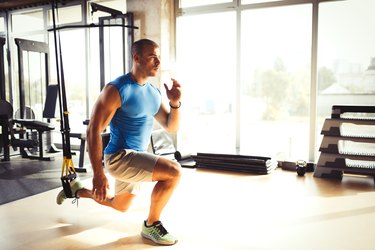
Though body-weight workouts are usually equipment-free, sometimes you need to amp things up without buying a rack of dumbbells. Enter: TRX. Those black and yellow straps you've likely seen at your gym (remember that place?) are great for strengthening your lower body (your upper body, too!).
"The TRX allows for more focus on individual leg movement patterns and stability," says Morgan Reese, certified personal trainer. Plus, you're able to perform power- and stability-focused moves without worrying about falling over, she says. Even though the straps provide assistance, that doesn't mean they make the moves easy or ineffective.
Video of the Day
Video of the Day
"TRX increases stability, balance and overall full-body muscle recruitment. It also greatly improves core strength and stability; your entire core is required for almost every TRX exercise, as you must leverage your own body weight as resistance," she says.
You can easily pack it up and travel with it, since you can attach it just about anywhere with an anchor — doorways, trees, poles and sturdy rails. Here are four TRX exercises you can integrate into your next lower-body workout.
Tip
Make sure the handles are even with each other so you're not unevenly distributing your weight. "This throws off the functionality of the exercise and compensates one side for another," Reese says.
And don't support too much of your weight by pulling your upper body toward the anchor point. The straps are there for stability and balance — not to take the work away from your legs!
1. Reverse Lunge
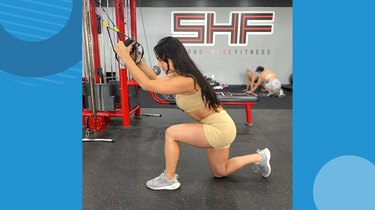
- Hold a TRX handle in each hand. You want the handles to hang about the same level as your waist. (The handle length can be adjusted to your liking).
- Position your feet shoulder-width apart.
- Step backward with your right leg and bend both knees to a 90-degree angle.
- Drive your left foot into the ground (your stationary leg) and stand up.
- Bring your right up in front of your hips to a 90-degree angle.
- Step back into a reverse lunge. Do all your reps on one side before repeating on the other leg.
Tip
One of the hardest things about lunging is balance and stability. But by using the TRX, you're able to better stabilize yourself, as well as increase the speed at which you're lunging.
"It allows you to focus on power, stability and strength all in one movement because you have an anchor for support," Reese says.
2. Squat Jump
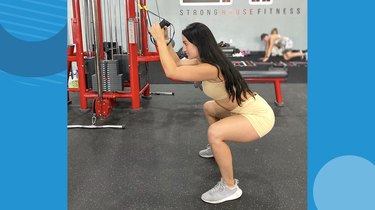
- Bring the TRX handles — one held in each hand — to hip level.
- Step back and extend your arms full so there's no slack on the TRX but a slight tension.
- Keep your weight shifted back onto your heels, though both feet should be flat on the ground.
- Drive through your heels and jump, keeping the tension in the straps.
- Land on both feet with knees slightly bent and immediately go into the next rep.
Tip
Squatting is one thing, but properly landing into a squat after a jump is difficult, so form is key. Make sure your hips, knees and ankles are in alignment when standing. And there's a tendency to allow the knees to bow inward during the squat, but you want to avoid doing so.
"A lot of the time people end up putting the weight on the front of their body and putting too much pressure on their knees," she says. The TRX allows for a softer landing that protects the joints in your knees.
3. Curtsy Lunge
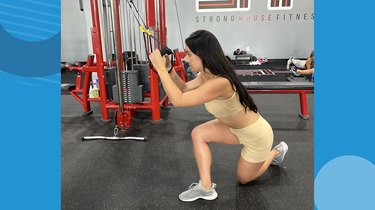
- Hold the handles of the TRX — one in each hand — at hip level. Space your feet shoulder-width apart.
- Step your left foot back and to the right until it crosses behind your right foot. Bend down as deeply as possible with your left knee slightly hovering above the floor.
- At the bottom of the movement, both knees should be bent at 90-degree angles where the front thigh is parallel to the ground. Keep the weight shifted back on your right heel.
- Press through your right leg to bring the left leg up to a 90-degree angle so that your knee is in line with your hip.
- Step back into your next rep.
- Complete all reps on one side before switching legs.
Tip
Unilateral lower-body movements are extremely effective at helping identify and correct one side being stronger than the other. And the curtsy lunge also introduces a diagonal movement pattern — targeting more of your hips and glutes — rather than just forward and back.
4. Assisted Pistol Squat
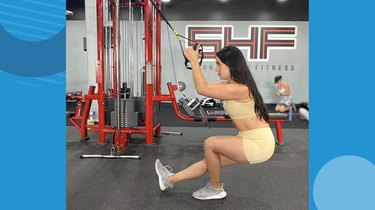
- Hold the handles of the TRX — one in each hand — at hip level. Space your feet shoulder-width apart.
- Extend your right leg out in front of you with your foot lightly touching or hovering above the ground.
- Bend your left knee and lower your body into a single-leg squat. Keep the weight mostly in your left heel but make sure your entire foot is touching the ground.
- Drive through your left heel as you stand back up, drawing your right knee up to a 90-degree angle to improve balance.
Tip
The TRX is great for exercise progressions, and the assisted pistol squat with the TRX supports your balance and stability so you can focus on single-leg strength, as well.
"This is one of the best ways to learn how to do a pistol squat," she says, as it can help you nail down the form on this advanced exercise.